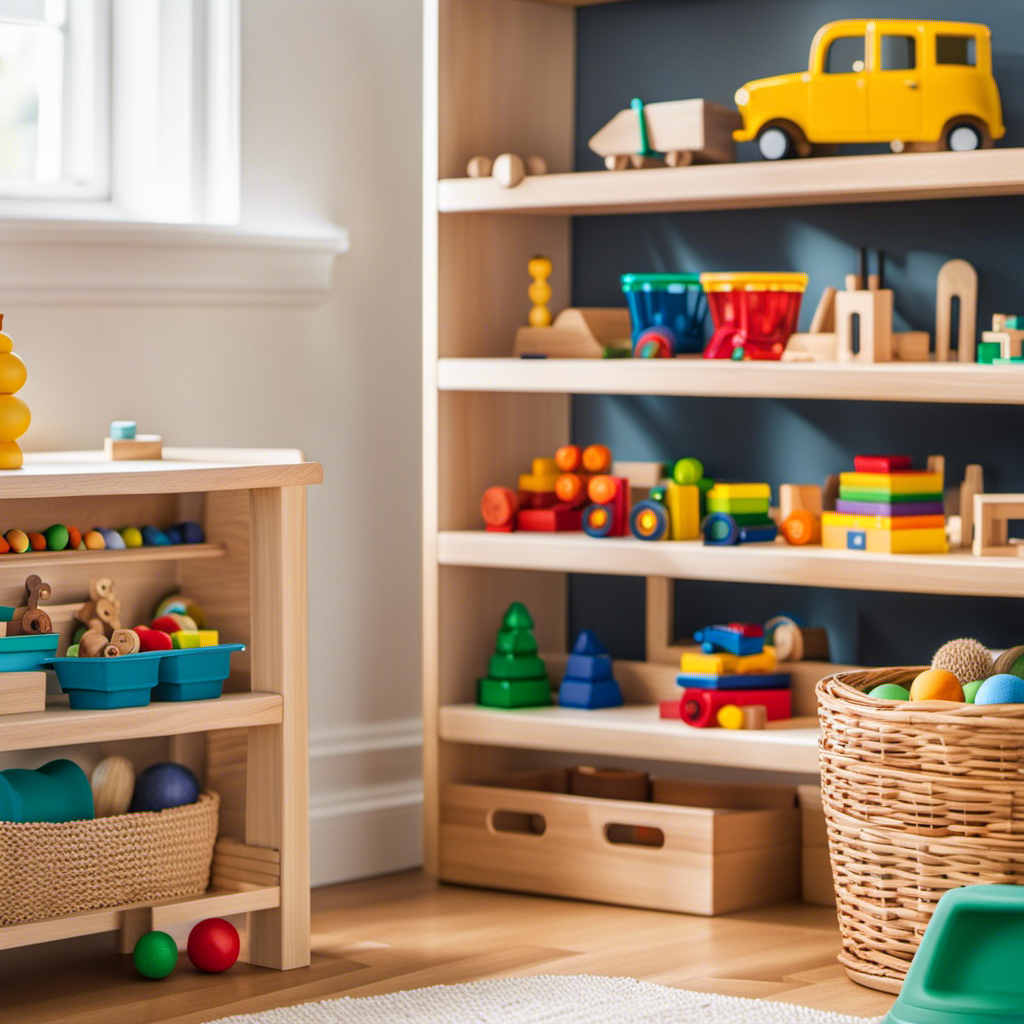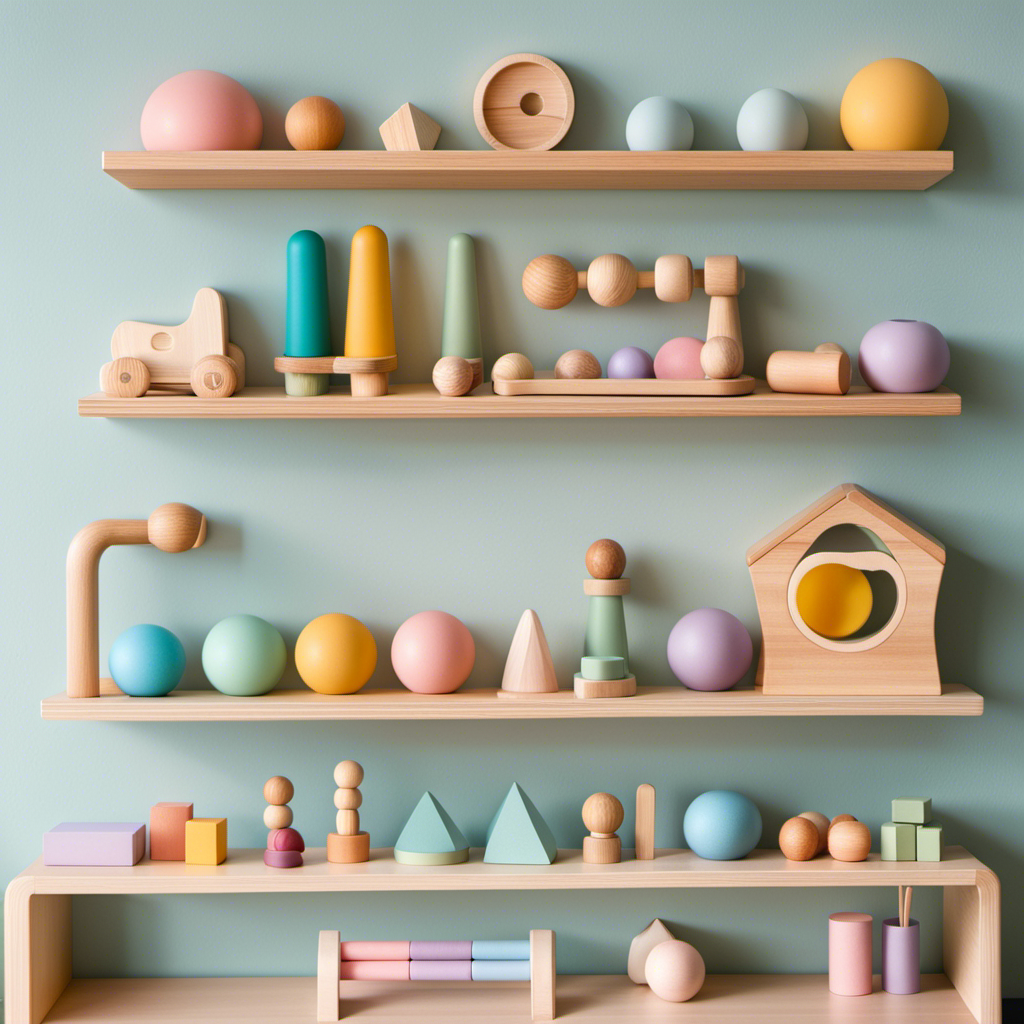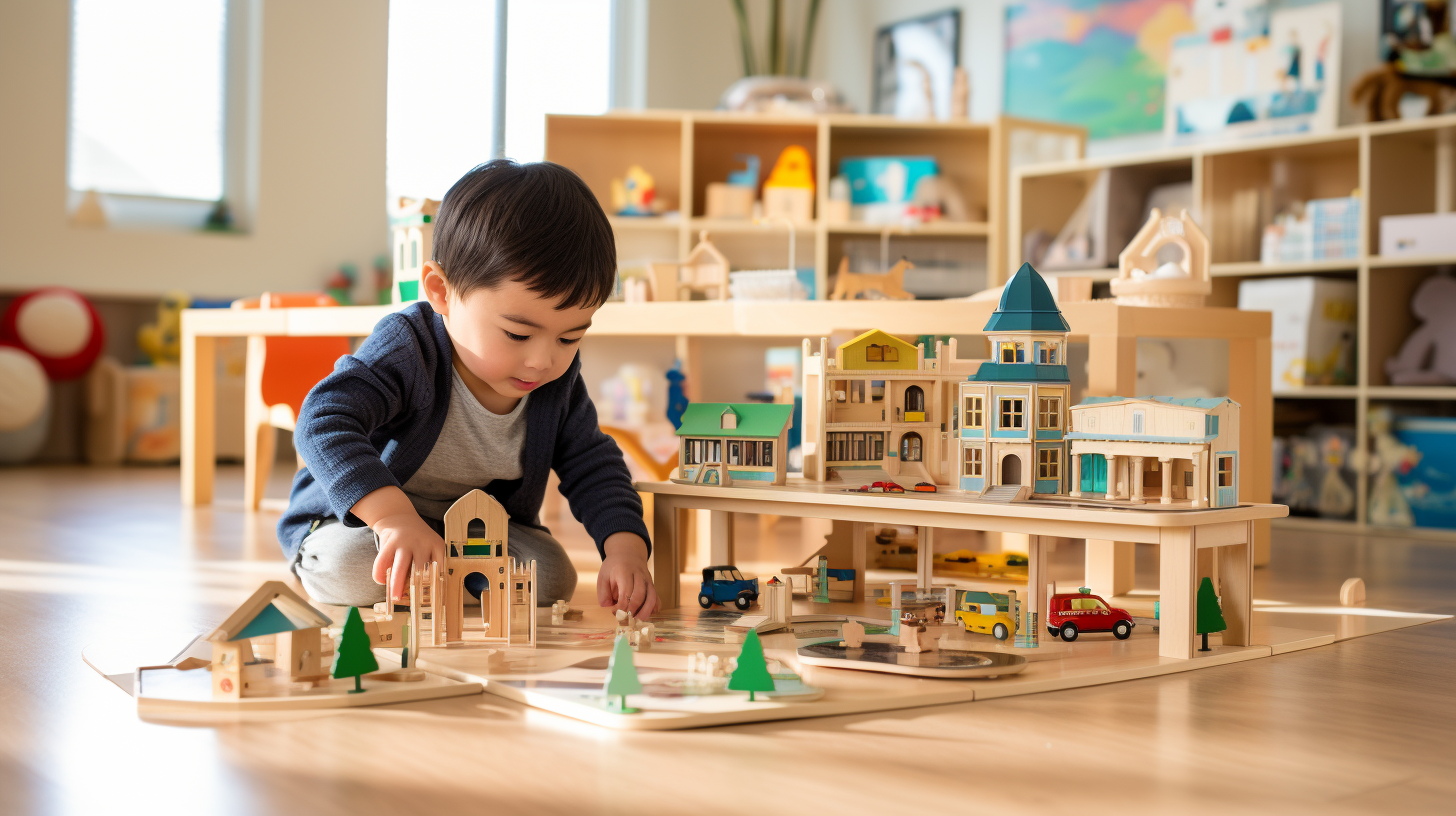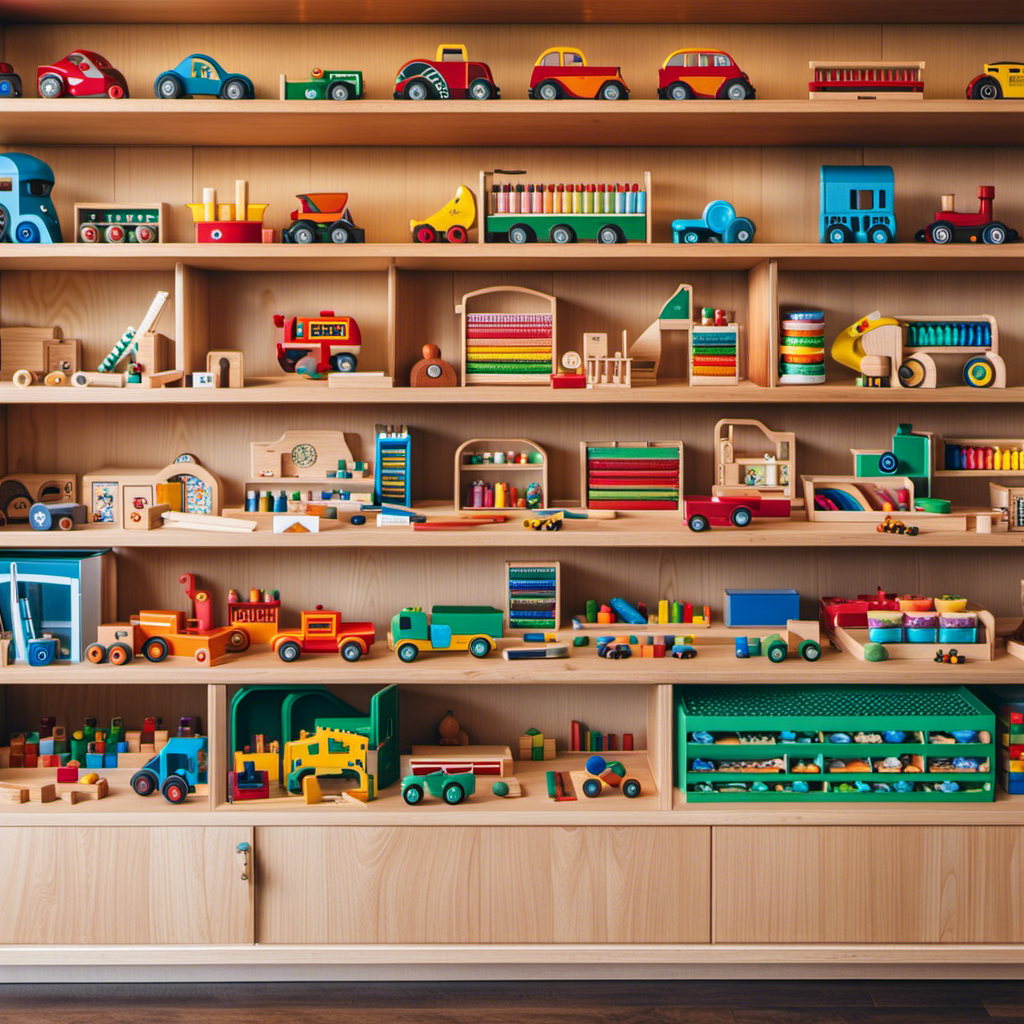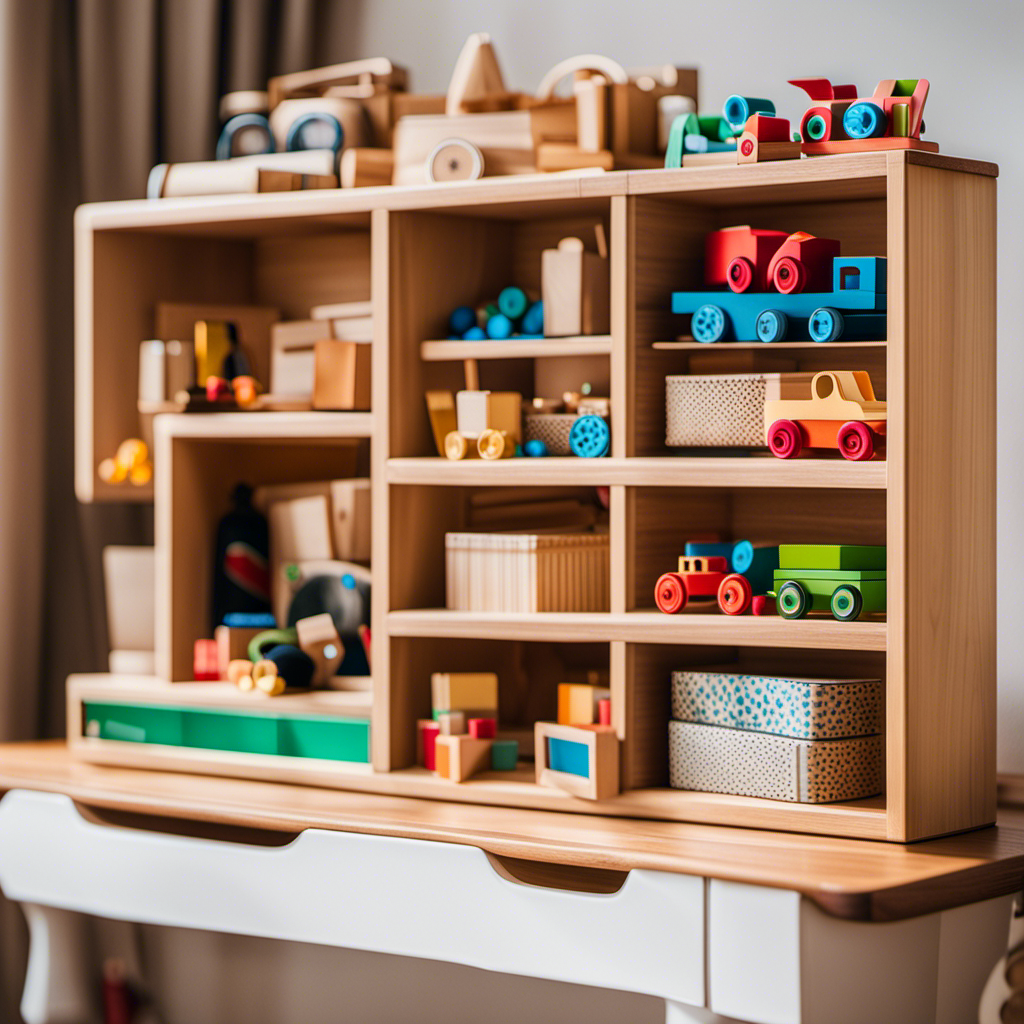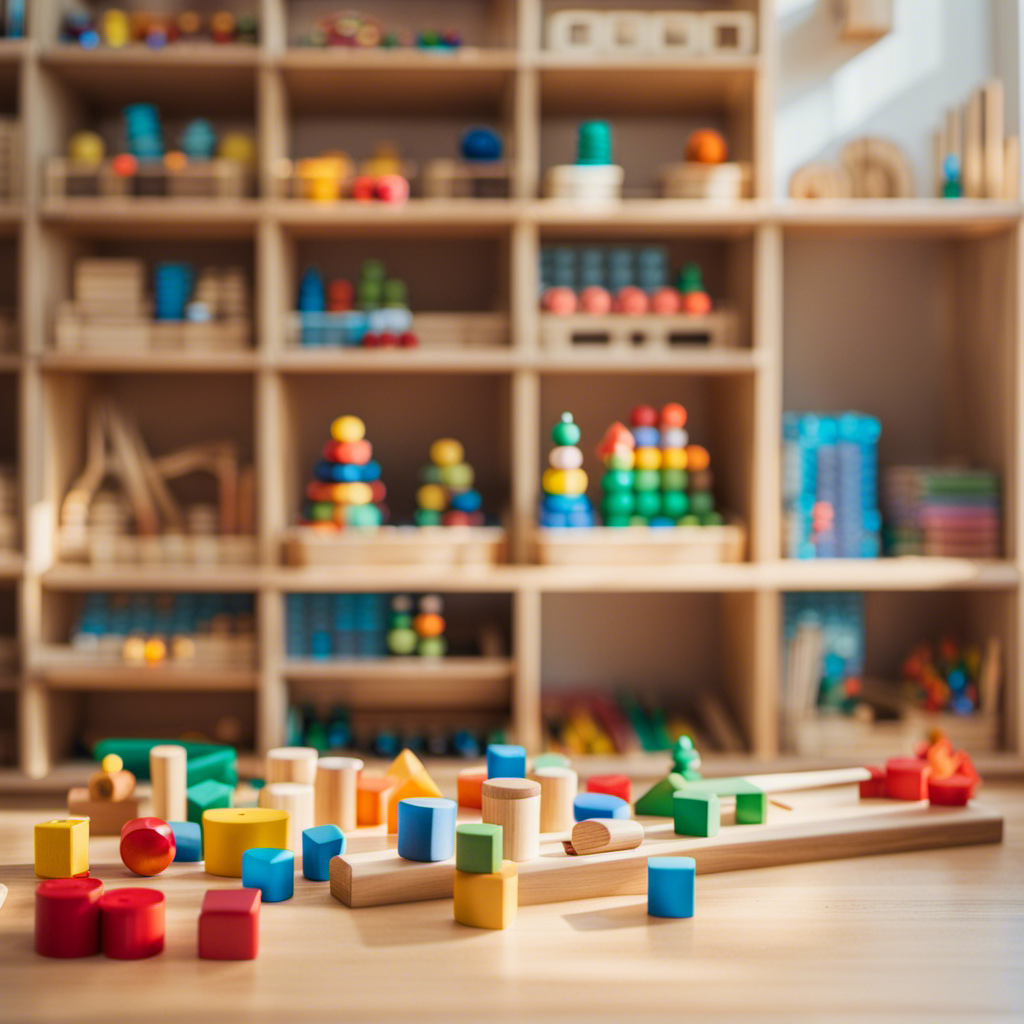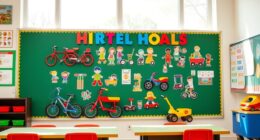As a parent, I empathize with the challenge of keeping my child’s toys organized and engaging. That’s why I’ve adopted the idea of toy rotation from the Montessori method.
Picture this: a rotating carousel of toys, each one carefully chosen to stimulate your child’s learning and development.
In this article, I’ll guide you through the process of setting up a toy rotation schedule, choosing the right toys, and creating an efficient storage system.
Get ready to bring new life to playtime with Montessori toy rotation.
Key Takeaways
- Toy rotation keeps children engaged and promotes independence
- Categorizing toys allows exploration of different concepts and skills
- Toy rotation reduces clutter and creates an organized play environment
- Involving the child in the toy selection process empowers them to have a say in their play environment.
The Importance of Toy Rotation in Montessori
Toy rotation is crucial in Montessori because it helps to keep children engaged and promotes their independence. By regularly switching out the toys available to children, they are able to maintain their interest and curiosity in their playthings.
One technique for toy rotation is to categorize toys based on their type or theme, and then rotate them on a weekly or monthly basis. This allows children to explore different concepts and develop a variety of skills.
Another technique is to set up different play areas around the house, each with a specific set of toys, and rotate the children’s access to these areas. By maximizing playtime with a limited selection of toys, children are encouraged to fully engage and explore the possibilities within their play environment.
Setting up a toy rotation schedule ensures that children always have a fresh and stimulating play experience without overwhelming them with too many choices at once.
Setting Up a Toy Rotation Schedule
I’ve found that implementing a toy rotation system in my home has numerous benefits for both my child and myself.
By regularly rotating the toys available to my child, I’ve noticed an increase in their focus and engagement during playtime.
Toy rotation also helps to minimize clutter and create a more organized and manageable play environment.
To establish a rotation system, I designate specific bins or shelves for each set of toys and create a schedule for rotating them on a weekly or monthly basis.
Benefits of Toy Rotation
You’ll notice a significant improvement in your child’s focus and creativity when implementing toy rotation.
One of the main benefits of toy rotation is that it helps prevent overstimulation. When children have access to a limited number of toys at a time, they are more likely to engage deeply with each one, fostering their concentration and imagination.
Additionally, toy rotation can help reduce clutter and create a more organized play environment. To implement toy rotation, start by sorting your child’s toys into different categories or themes. Then, create a schedule or system for rotating the toys. This could involve rotating toys weekly, bi-weekly, or even monthly.
By regularly introducing new toys and removing old ones, you’ll keep your child engaged and excited about their playtime.
Now, let’s move on to establishing a rotation system without writing ‘step’.
Establishing a Rotation System
Creating a consistent schedule for rotating your child’s playthings is key to establishing an effective toy rotation system. By regularly swapping out toys, you can provide your child with a fresh and engaging play experience while also reaping the benefits of toy rotation.
Here are three steps to help you establish a successful rotation system:
-
Sort and categorize: Begin by categorizing your child’s toys into different groups based on their type or theme. This will make it easier to plan rotations and ensure a variety of toys are included in each rotation.
-
Set a schedule: Determine how often you want to rotate the toys. Some parents opt for weekly rotations, while others prefer monthly or even quarterly. Choose a schedule that works best for you and your child’s play habits.
-
Store and display: Use storage containers or shelves to organize and display the toys that are not currently in rotation. This will make it easier to keep track of what toys are available and create excitement when it’s time to switch them out.
By establishing a rotation system, you can keep your child engaged and excited about their toys while also promoting creativity and reducing clutter.
Now, let’s move on to the next section about choosing the right toys for rotation.
Choosing the Right Toys for Rotation
When choosing the right toys for rotation, it’s important to consider the child’s interests and developmental stage. By selecting toys that align with their current skills and passions, you can create an engaging and enriching play experience. To help you make informed choices, I’ve created a table below that outlines different toy categories and their corresponding benefits for different developmental stages:
| Developmental Stage | Toy Category |
|---|---|
| Infants | Soft toys, rattles, |
| teething toys | |
| Toddlers | Blocks, shape sorters, |
| pretend play sets | |
| Preschoolers | Puzzles, art supplies, |
| building blocks | |
| School-age | Board games, science kits, |
| children | musical instruments |
Creating a Toy Storage System
To maximize organization and accessibility, consider implementing a toy storage system that allows for easy rotation of playthings. Here are some toy rotation tips to help you organize your playroom efficiently:
-
Categorize toys: Sort your toys into different categories, such as building blocks, puzzles, or stuffed animals. This will make it easier to rotate them and keep track of what you have.
-
Use clear bins: Opt for clear storage bins so you can easily see what’s inside without having to open them. Label each bin with the category of toys it contains.
-
Label bins with pictures: If your child is too young to read, use pictures or symbols to label the bins. This will help them identify where each toy belongs and encourage them to put things back in the right place.
Organizing and Labeling Toy Bins
Labeling toy bins is a simple yet effective way to keep toys organized and easily accessible. By clearly labeling each bin with a specific category or type of toy, it becomes much easier to maintain an organized toy rotation system.
This not only saves time and effort when searching for specific toys, but it also encourages children to engage in more diverse play and fosters their independence and responsibility in cleaning up after playtime.
Benefits of Labeling
You can easily see the benefits of labeling your child’s toys in a Montessori setting. Organization plays a crucial role in a child’s development, and labeling the toys is a practical way to achieve that. Here are three reasons why labeling is beneficial:
-
Clear Identification: Labels help children easily find and select the toys they want to play with. It saves time and reduces frustration, allowing them to focus on their play and exploration.
-
Language Development: By labeling toys, children are exposed to written words regularly. This exposure enhances their vocabulary, reading skills, and understanding of language concepts.
-
Independence and Responsibility: Labeling encourages children to take responsibility for tidying up and putting toys back in their designated places. It instills a sense of ownership and teaches them important life skills.
With a well-organized and labeled toy system, we can now move on to the next step of efficient toy rotation.
Efficient Toy Rotation
Now that we understand the benefits of labeling our toys, let’s dive into the process of efficient toy rotation.
Toy rotation is not only about organizing and decluttering, but also about making it a fun and interactive experience for your child. One way to make toy rotation enjoyable is by involving your child in the toy selection process. Allow them to choose which toys they want to keep out and which ones they want to put away. This not only gives them a sense of autonomy but also helps them develop decision-making skills.
By involving them in the process, they will be more excited about playing with the toys they have chosen, and it will create a sense of anticipation for when the next set of toys is rotated in.
Now that we have discussed how to make toy rotation fun, let’s explore the next section on implementing a smooth toy transition process.
Implementing a Smooth Toy Transition Process
When it’s time to rotate toys in a Montessori environment, it’s important to establish a smooth transition process. Here are four steps to help you implement a gradual toy transition process and involve your child in the decision-making:
-
Assess your child’s current interests and developmental needs: Observe what toys your child is gravitating towards and consider their age and stage of development.
-
Select a few toys to rotate: Choose a small number of toys to rotate, keeping in mind your child’s interests and developmental goals.
-
Involve your child in the process: Let your child help choose which toys to put away and which ones to bring out. This empowers them and allows them to have a say in their play environment.
-
Introduce the new toys gradually: Instead of swapping out all the toys at once, gradually introduce new ones over time to avoid overwhelming your child.
By implementing a gradual toy transition process and involving your child in the decision-making, you can create a smooth and engaging toy rotation experience for them.
In the next section, we will explore how to further engage your child in the toy rotation process.
Engaging Your Child in the Toy Rotation Process
To engage your child in the process of rotating their toys, consider incorporating fun and interactive activities that encourage exploration and creativity.
One idea is to create a toy exploration station where your child can discover and play with the toys that are currently rotated out. This station can include different stations for building, art, and imaginative play.
Another engaging activity is to involve your child in the process of choosing which toys to rotate out. This can be done by creating a visual display of all the toys and allowing your child to select which ones they want to play with for the next rotation.
By involving your child in the decision-making process and providing engaging activities, you can make toy rotation an exciting and interactive experience for them.
Now let’s explore how to monitor and assess the effectiveness of toy rotation.
Monitoring and Assessing the Effectiveness of Toy Rotation
You can evaluate the effectiveness of toy rotation by observing how engaged and interested your child is in the toys that are currently in rotation. It’s important to regularly monitor their progress to ensure that the toy rotation system is actually benefiting your child’s development.
Assessing the effectiveness of toy rotation involves paying attention to your child’s level of interest and engagement with the toys. Are they actively playing with the toys? Are they exploring different materials and activities? Do they seem excited when you introduce new toys? By keeping a close eye on these aspects, you can determine if the current rotation is meeting your child’s needs.
If you notice a lack of interest or engagement, it may be time to make adjustments to the rotation or introduce new toys that align with your child’s interests and developmental stage. This will help to keep the toy rotation process fresh and engaging for your child.
Now, let’s explore some common challenges that may arise during toy rotation and how to troubleshoot them.
Troubleshooting Common Challenges in Toy Rotation
If your child loses interest in the toys during rotation, it may be helpful to introduce new materials or activities that align with their current interests and developmental stage. This will help to keep them engaged and excited about the toys in the rotation.
However, there are some common challenges that may arise when implementing a toy rotation system. Here are some troubleshooting tips to overcome these challenges:
-
Lack of variety: Ensure that you have a diverse collection of toys that cater to different interests and developmental areas.
-
Overwhelming choices: Limit the number of toys available at a time to avoid overwhelming your child.
-
Lack of organization: Keep the toys well-organized and easily accessible, so your child can independently choose and play with them.
-
Resistance to change: Gradually introduce new toys into the rotation to help your child adapt to change.
-
Age appropriateness: Regularly assess and update the toys to ensure they are suitable for your child’s current developmental stage.
Frequently Asked Questions
How Often Should I Rotate My Child’s Toys?
When is the best time to rotate toys?
As a parent, I’ve found that it’s helpful to rotate my child’s toys every few weeks. This allows for variety and keeps them engaged and interested in their playtime.
Toy rotation can enhance a child’s learning by introducing new concepts and skills through different toys. It also helps prevent boredom and encourages creativity.
What Are the Benefits of Toy Rotation in Montessori?
Toy rotation in Montessori has numerous benefits. It’s like a breath of fresh air for my child’s creativity, allowing them to explore different toys and activities.
By reducing overstimulation, rotation helps them stay focused and engaged.
It also fosters independence, as they learn to choose and organize their own toys.
Problem-solving skills are honed as they figure out how to play with different toys.
Overall, toy rotation is a practical and effective way to support my child’s development.
How Do I Decide Which Toys to Include in the Rotation?
When it comes to choosing appropriate toys for rotation, I consider a few factors.
First, I look at the developmental stage of my child and choose toys that align with their current skills and interests.
I also consider the Montessori principles of promoting independence and fostering exploration.
Next, I think about variety and balance, selecting toys that offer different experiences and stimulate various senses.
Should I Involve My Child in the Toy Rotation Process?
Involving your child in the toy rotation process is a great way to foster their independence and decision-making skills.
Play is crucial for a child’s development, and by allowing them to choose which toys to include in the rotation, you are giving them a sense of ownership and agency.
It also teaches them how to prioritize and make choices.
How Can I Track the Effectiveness of Toy Rotation in My Child’s Development?
Tracking the effectiveness of toy rotation in my child’s development is crucial. I observe how my child engages with different toys and note any changes in their cognitive, social, and emotional skills.
I also keep a record of their progress by documenting their play patterns, interests, and milestones. This helps me understand the impact of toy rotation on their overall development.
Additionally, I regularly communicate with teachers and caregivers to gain valuable insights into my child’s growth and adjust the toy rotation accordingly.
Conclusion
In conclusion, toy rotation in Montessori is like a symphony, with each toy playing its own harmonious tune. By setting up a schedule, choosing the right toys, and creating an organized storage system, we create an environment that fosters curiosity and growth.
Engaging our child in the process adds an extra layer of excitement and ownership. As we monitor and assess the effectiveness of toy rotation, we fine-tune this beautiful melody, ensuring our child’s development is nurtured.
Through toy rotation, we unlock the magic of learning, creating a world where every toy has a purpose and every child thrives.
Tina is the heart and soul behind Toddler Ride On Toys. With a passion for early childhood education and a deep understanding of child development, Tina ensures that every piece of content on our website reflects our commitment to playful learning. Her expertise in Montessori, Preschool, STEM, and Waldorf education philosophies helps shape our website into a valuable resource for parents, caregivers, and educators.
